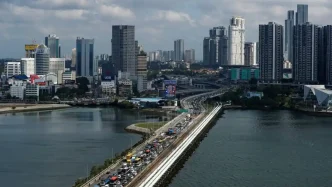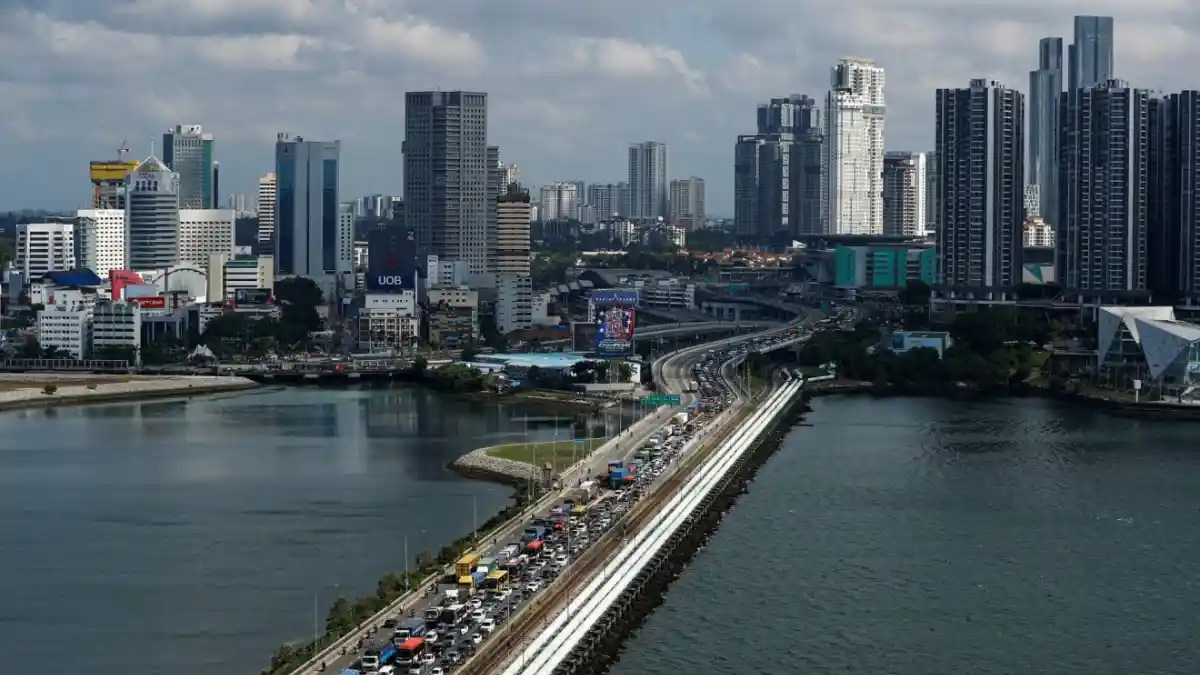In a bid to ease the daily grind for thousands of commuters traveling between Singapore and Johor, authorities from both sides are exploring innovative transport solutions. Following a high-level meeting on August 1, 2025, between Singapore’s Acting Transport Minister Jeffrey Siow and Johor’s Chief Minister Onn Hafiz Ghazi, discussions have centered on enhancing cross-border connectivity, though no concrete decisions have been made on liberalizing ride-hailing services. The talks signal a shared intent to address congestion and commuter demand while balancing the interests of transport workers.
Clarifying Cross-Border Ride-Hailing Proposals
The Land Transport Authority (LTA) of Singapore issued a statement on August 3, 2025, clarifying that while cross-border ride-hailing services were discussed during the ministerial meeting, no final agreement was reached. This came after some Malaysian media outlets reported that both sides had proposed introducing such services as an alternative for commuters. The LTA emphasized its openness to ideas that improve cross-border travel but stopped short of endorsing a full liberalization of ride-hailing options across the Causeway.
Instead, the authority highlighted the existing Cross-Border Taxi Scheme (CBTS), which permits up to 200 licensed taxis from each country to ferry passengers between designated points. Currently, Singapore taxis can pick up and drop off passengers at Larkin Sentral in Johor Bahru, while Malaysian taxis operate from Ban San Street Terminal in Rochor, Singapore. However, the LTA noted that the full quota of taxis under this scheme remains underutilized, suggesting room for better uptake before introducing new systems.
To address commuter needs, the LTA is considering expanding the number of boarding and alighting points in both countries. Additionally, authorities are exploring the integration of ride-hailing apps to facilitate bookings for licensed taxis on cross-border routes. The authority underscored that any adjustments to the transport regime would prioritize commuter convenience while protecting the livelihoods of taxi and private-hire drivers.
Johor’s Vision for Reduced Congestion and Economic Gains
Johor’s Chief Minister Onn Hafiz Ghazi expressed optimism about the potential of cross-border ride-hailing services in a Facebook post on August 1, 2025. He suggested that such a system could alleviate congestion at border checkpoints, a persistent issue for daily commuters. Moreover, he highlighted the economic benefits, noting that it could create income opportunities for Malaysian drivers while fostering a more competitive and user-friendly transport ecosystem. His remarks, reported in Malaysian media, also pointed to the broader goal of strengthening integration between the public transport networks of Singapore and Johor.
The daily commute between Singapore and Johor Bahru is a critical lifeline for many workers and businesses, with thousands crossing the Causeway each day. Congestion at checkpoints, particularly during peak hours, has long been a pain point, prompting calls for innovative solutions. The discussions on ride-hailing reflect a recognition of the need for flexible, on-demand transport options that could complement existing bus and taxi services.
Enhancing Bus Services for Early Morning Commuters
Beyond ride-hailing, the ministerial meeting also addressed improvements to cross-border bus services. The LTA revealed that it is reviewing a request from Malaysia’s Land Public Transport Agency to start bus operations from Johor Bahru an hour earlier, at 4 am instead of the current 5 am. This adjustment aims to alleviate crowding during early morning hours, a time when many workers travel to Singapore for employment.
The authority is assessing whether the operating times of these services can align with the start of local bus and MRT services in Singapore, ensuring seamless connectivity for arriving passengers. SBS Transit, one of Singapore’s major public transport operators, currently runs Service 160 from Johor Bahru Checkpoint starting at 5 am on weekdays and 5:50 am on weekends and public holidays. It also operates Service 170 between Larkin Terminal in Johor Bahru and Queen Street Terminal near Jalan Besar, with departures from 5:20 am on weekdays and 5:30 am on weekends and holidays.
SMRT, another key operator, manages Service 950 across the Causeway from Johor Bahru Checkpoint to Woodlands Temporary Bus Interchange. While specific start times for Singapore-bound services were not publicly detailed, Johor Bahru-bound buses depart from Woodlands at 5:30 am daily. The LTA is also engaging with private bus operators to explore the feasibility of earlier start times, potentially at higher fares, to meet demand during these critical early hours.
Balancing Innovation with Worker Protections
Acting Transport Minister Jeffrey Siow, in a Facebook post on August 3, 2025, underscored the multifaceted nature of the discussions with Johor’s leadership. Beyond transport logistics, the talks covered the importance of safeguarding the interests of drivers and platform workers. He also noted that the LTA has been intensifying enforcement against illegal passenger and delivery services, signaling a commitment to maintaining a regulated transport environment amid potential innovations.
The emphasis on worker protections is particularly relevant given the rise of gig economy platforms across Southeast Asia. Ride-hailing services like Grab, which operates in both Singapore and Malaysia, have transformed urban mobility but also raised concerns about driver earnings and job security. Any move to introduce or expand cross-border ride-hailing would need to navigate these complex issues, ensuring that technological advancements do not come at the expense of local livelihoods.
Economic and Social Implications of Cross-Border Connectivity
The Singapore-Johor corridor is more than just a transport route; it is a vital economic artery linking two dynamic regions. Johor Bahru serves as a manufacturing and service hub for many Singapore-based companies, while Singapore offers employment and business opportunities for Malaysians. Improving transport links could boost economic activity on both sides, facilitating the flow of goods, services, and labor.
However, the challenges are significant. Congestion at the Causeway and Johor Bahru Checkpoint often leads to delays, impacting productivity and quality of life for commuters. Public transport options, while extensive, struggle to keep pace with demand during peak periods. The potential introduction of ride-hailing services or expanded taxi operations could offer a flexible solution, but it requires careful coordination to avoid exacerbating existing issues, such as unregulated operators or fare disparities.
Socially, stronger transport links could deepen ties between the communities of Singapore and Johor. Cross-border travel is not just about work; it encompasses family visits, tourism, and cultural exchange. A more integrated transport system could make these interactions more seamless, reinforcing the shared history and interconnectedness of the two regions.
Regional Context and Future Prospects
The discussions between Singapore and Johor come at a time when Southeast Asian nations are increasingly focused on regional connectivity. Projects like the Johor Baru-Singapore Rapid Transit System Link (RTS Link), set to be operational by late 2026, aim to transform cross-border travel with high-capacity rail services. While such infrastructure projects address long-term needs, interim measures like enhanced bus timings and taxi schemes are crucial for addressing immediate commuter challenges.
Other ASEAN countries are also grappling with similar issues at their borders. For instance, Thailand and Malaysia have explored cross-border transport initiatives to facilitate movement between southern Thai provinces and northern Malaysian states. These efforts highlight a broader regional trend toward integration, driven by economic imperatives and the need for efficient mobility in an increasingly interconnected world.
Yet, the path forward for Singapore and Johor is not without hurdles. Regulatory differences, border security concerns, and the economic impact on local transport operators must all be carefully weighed. The LTA’s cautious approach—focusing on maximizing existing schemes like the CBTS before introducing new systems—reflects an awareness of these complexities.
Looking Ahead: A Collaborative Path to Mobility
As Singapore and Johor continue to navigate the intricacies of cross-border transport, the focus remains on collaboration and incremental progress. The recent ministerial talks, while not yielding immediate policy changes, have laid the groundwork for future innovations. Whether through earlier bus services, expanded taxi operations, or the potential integration of ride-hailing apps, both sides are committed to improving the commuter experience.
The stakes are high for the thousands who traverse the Causeway daily, balancing work, family, and personal commitments across borders. As these discussions evolve, the question looms: can Singapore and Johor craft a transport model that serves as a blueprint for regional cooperation, balancing innovation with equity? For now, commuters and stakeholders alike await the next steps with cautious optimism.
















